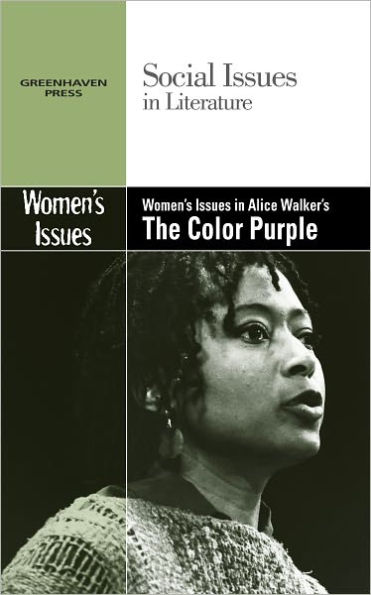
Women's Issues in Alice Walker's The Color Purple
168
Women's Issues in Alice Walker's The Color Purple
168Hardcover(Library Binding)
-
PICK UP IN STORECheck Availability at Nearby Stores
Available within 2 business hours
Related collections and offers
Overview

Product Details
| ISBN-13: | 9780737752700 |
|---|---|
| Publisher: | Greenhaven Publishing LLC |
| Publication date: | 04/09/2011 |
| Series: | Social Issues in Literature Series |
| Pages: | 168 |
| Product dimensions: | 6.10(w) x 9.10(h) x 0.60(d) |
| Age Range: | 15 - 17 Years |
Table of Contents
Introduction 9
Chronology 12
Chapter 1 Background on Alice Walker
1 Walker's Childhood, Education, and Crusade for African American Women Barbara T. Christian 16
Walker was active in the civil rights movement and pioneered the study of the relationship between black men and women.
2 Alice Walker's Childhood Sense of Betrayal Evelyn C. White 24
Alice Walker's blinding in one eye and disfigurement when she was eight years old left her traumatized for life.
3 Feeling Like an Outsider Maria Lauret 31
Walker appreciated a sense of community in her childhood but has seen herself as an outsider, whether it is in her family or among her literary peers.
Chapter 2 The Color Purple and Women's Issues
1 From Being Dominated to Taking Charge Donna Haisty Winchell 39
The Color Purple paints a picture of a cruel, male-dominated society that leads Celie to lose her love for men and create a reversal in gender roles.
2 Being Deprived of a Mother's Bond Charles L. Proudfit 50
Celie's damaging relationship with her mentally ill mother sets her in search of other female bonds.
3 The Myth of the Rape and Silencing of Philomela Informs The Color Purple Martha J. Cutter 58
Like the mythical Philomela, Celie is raped and silenced, but her symbolic connections with blood and birds lead her, unlike Philomela, to creativity and freedom.
4 Walker Revises Traditional Gender Roles Mae G. Henderson 65
In a culture of male cruelty, women sacrifice for one another and replace traditional marriage with an extended family.
5 Trading Male Literary Traditions for Female Oral Ones Valerie Babb 74
The black woman's oral tradition (in which the novel is written) supersedes the white male's written one.
6 Walker's Relationship with the African American Male Philip M. Royster 81
The male audiences of Walker's novel and the film made from the novel were vocal and outraged at the picture she drew of black men as cruel and heartless.
7 Folk Art as a Means to Female Survival Keith E. Byerman 89
In The Color Purple women use folk wisdom to overcome their male oppressors. Folk art, including sewing and singing, makes it possible for them to survive, have their revenge, and tell about their pain.
8 Male Cruelty Leads to Positive Changes Henry O. Dixon 98
Male cruelty in The Color Purple leads to positive development in the lives of female characters.
9 Centering on Women but Ignoring Race and Economics bell hooks 108
The novel, while attacking the exploitation of females in an African American community, fails to challenge the whole system of racial and class exploitation.
10 The Color Purple Is a Disservice to Black Women Trudier Harris 113
In taking an independent view of the novel, one finds an unbelievably subservient, uncomplaining protagonist and white stereotypes of black men and women.
Chapter 3 Contemporary Perspectives on Women's Issues
1 Women Achieve Social Change Through Folk Art Anne Constable 125
Around the world, women find economic and social power through cooperation and the revival of traditional art in a misogynistic society.
2 Domestic Violence Retains Cultural Momentum Worldwide Sonya Weakley 130
One in three women is abused worldwide. Abuse of women is so ingrained in cultures that victims will rarely testify in court about the abuse.
3 Conflicting Feminist Ideologies Among Black Women Patricia Hill Collins 134
The black women who recognize and want to work for the betterment of their sisters are hampered by their conflicting ideologies.
4 A Black Celebrity Decides to Make Her Sexual Orientation Known Ari Karpel 141
After'Wanda Sykes told the public that she is a lesbian, she became a spokesperson for black and gay America.
For Further Discussion 151
For Further Reading 152
Bibliography 153
Index 158
